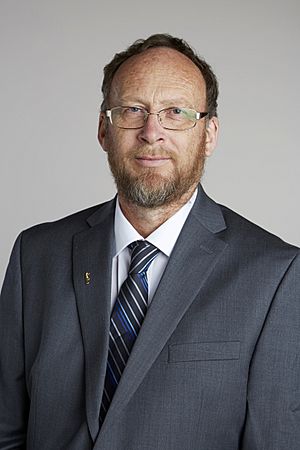Colin Wilson (volcanologist) facts for kids
Quick facts for kids
Colin Wilson
FRS FRSNZ
|
|
|---|---|

Colin Wilson in 2015, portrait from the Royal Society
|
|
| Born |
Colin James Ness Wilson
19 July 1956 Wantage, Oxfordshire
|
| Alma mater | Imperial College London (BSc, PhD) |
| Known for | Volcanology of New Zealand |
| Awards |
|
| Scientific career | |
| Fields |
|
| Institutions |
|
| Thesis | Studies on the origins and emplacement of pyroclastic flows (1981) |
Colin James Ness Wilson is a famous scientist who studies volcanoes. He was born on July 19, 1956. He is a Professor of Volcanology at Victoria University of Wellington in New Zealand. His work helps us understand how volcanoes erupt and what happens during big eruptions.
Contents
Becoming a Volcanologist
Colin Wilson studied at Imperial College London. He earned his first degree in Geology in 1977. Geology is the study of Earth's solid features, like rocks and mountains.
Studying Volcanoes
He then completed his PhD in 1981. His research focused on pyroclastic flows. These are fast-moving currents of hot gas and volcanic rock. They can rush down the sides of a volcano during an eruption.
Amazing Discoveries and Awards
Professor Wilson is known for his important work on explosive volcanoes. He studies how these powerful eruptions happen. He also looks at how the Earth's crust (its outer layer) is affected by molten rock, called magma.
Understanding Explosive Eruptions
He gathers detailed information from old and new eruption sites. This helps him understand how huge volcanic events happened in the past. His studies have given us new ideas about dangerous volcanic activity. They also help us measure the size of ancient eruptions.
Studying Super-Eruptions
Professor Wilson also combines his field work with new ways to analyze data. He studies how large magma chambers behave in modern volcanoes. These are the underground areas where molten rock collects. Some of his work focuses on "super-eruptions," which are extremely powerful volcanic events.
Recognized for His Work
Because of his important contributions, Colin Wilson has received many awards.
- In 2001, he became a Fellow of the Royal Society of New Zealand. This is a group of top scientists in New Zealand.
- In 2015, he was chosen as a Fellow of the Royal Society. This is a very high honor for scientists in the United Kingdom.
- In 2017, he received the Rutherford Medal. This is New Zealand's highest science award. He earned it for his research on how large volcanoes act before and during explosive eruptions. This includes the eruptions that formed Lake Taupō.

